If you’re anything like me, you love your backyard chickens and would do anything to keep them happy and healthy. And with winter around the corner, it’s time to start thinking about ensuring your feathered friends stay warm and comfortable during the chilly months ahead.
But keeping your chickens warm doesn’t have to break the bank. There are plenty of affordable and practical ways ensure they stay cozy without spending much money. In this blog post, we’ll share ten tips for keeping your chickens warm this winter using what you have around your homestead.
Regarding frugal living, you want the best way to do something for the least amount of money. Unfortunately, this winter here in upstate New York has been frigid.
With temperatures below freezing and highs in the -2. It’s been brutal, so I have gathered up our best tips on how we are keeping our chickens warm this winter and how you can, too.
This is our seventh winter on our little farm, but we have lived in cold, harsh winters all our lives.
We don’t use a heat lamp with our chickens. I read many things about the realization you don’t need one, but a few of our chickens did get frostbite a few days ago when the temperatures dipped into the single digits and negatives overnight. I quickly realized some mistakes that we made.
We did a few things wrong, and I want to share with you how we fixed it, and it’s working for us now.
Here are 7 Frugal Ways to Keep your Chickens Warm this winter
Just after 6 a.m., I went out to the barn to let the chickens out. I knew they would need water a path shoveled to come out to the heated bucket of water.
Our winter has been the coldest this year since we started raising chickens five years ago. So the chickens haven’t left the barn for the past few days- not even for water.
So, I have been making several trips to the barn to fill up some water bowls. That was getting old. The ducks weren’t even coming down for water. The wind was just too brutal.
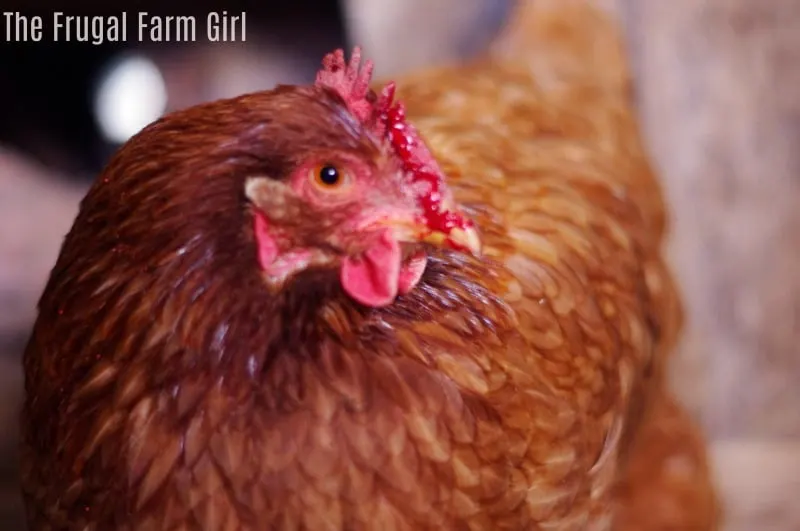
Then I saw a chicken with blood, and her feathers pulled back, and I immediately thought she got attacked. I looked around the barn, but nothing. Then I looked closer and realized she had frostbite.
Tip: When our chickens got frostbite, I would put them in a small dog crate with a bunch of straw and bring them in the garage. I kept them hydrated and fed away from the flock until they warmed up.
In the past, when a chicken was sick or had an injury, we kept it in a dog crate in the barn with the others, but given the temperature, I decided the garage would be a bit warmer.
You also don’t want to bring them to a heated area, as a drastic warm-up isn’t suitable for the affected area.
The other chickens were probably pecking at her blood, which worsened the whole scene. I walked around the barn and saw a few other chickens had black spots on their combs.
I felt awful. Now after living here in the country for seven years, I make sure to winterize our chicken coop in the fall.
USE OLD CHICKEN FEED BAGS TO FILL DRAFT HOLES
Our biggest mistake was NOT having every hole in the coop filled. Overnight temperatures are the lowest they have been with this flock. Most frostbite occurs during the night.
We save all our chicken food bags and have them sitting in a corner in the barn. It is incredible how thick these are.
I shoved these bags into holes and stapled them to the walls where any holes were—the cost to do this- Nothing.
I’m not sure why I thought just covering their window last year was good enough- although the previous year, 2017, our winter was not as harsh.
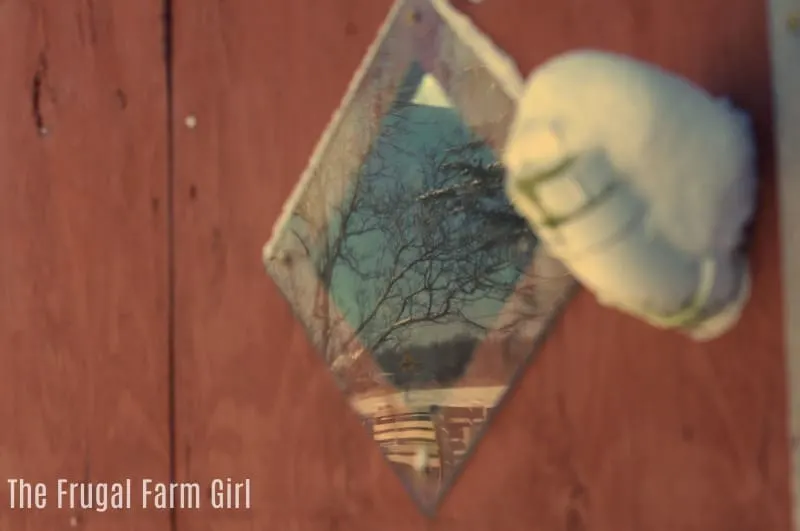
USE PLEXIGLASS TO INSULATE & LET SUN HEAT COOP
We have two chicken coops. Before we moved out to the country, I had my six chickens in the town living across the street from Walmart! It was an adventure. My husband built that chicken coop and used Plexi Glass on the side. This allows light into the coop, but we don’t have to worry about insulating this in the winter.
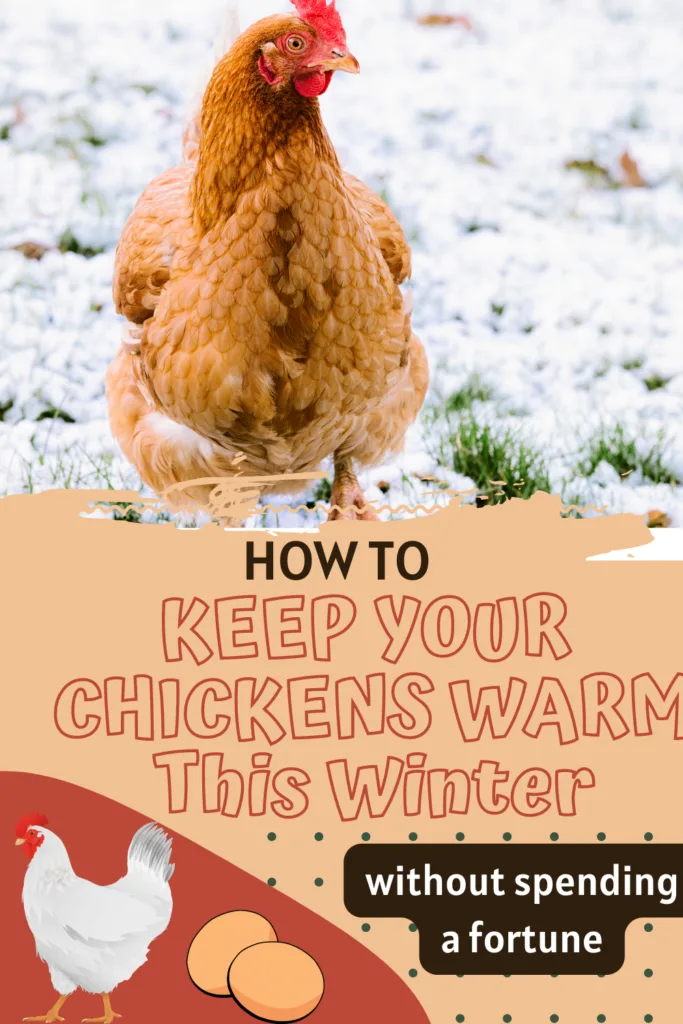
HAVE ADEQUATE VENTILATION
To prevent ammonia build-up, you must have adequate ventilation in any building where chickens live. You don’t want your chickens exposed to high levels of this toxic gas, so ensure that you include plenty of vents in the design when you’re building the chicken coop.
If chickens breathe in a lot of ammonia, they will have to pant like dogs when it’s hot, which means that your chickens will be spending less time laying and panting, which is unhealthy for them and makes egg production drop dramatically.
Keep the coop dry.
Moisture in the coop can make your chickens feel colder than they are. Ensure your coop stays dry by providing proper ventilation and cleaning up any wet spots or leaks.
Keep Their Food and Water filled to the top
It’s also important to keep chickens’ water filled all the time. The chickens will drink much more often when it’s extremely cold or hot out, so ensure that there is always plenty of water available for them, as they will quickly become dehydrated if their water supply runs low.
The chickens’ food also needs to be available at all times. Keeping chickens fed will not only keep them warm but also happy.
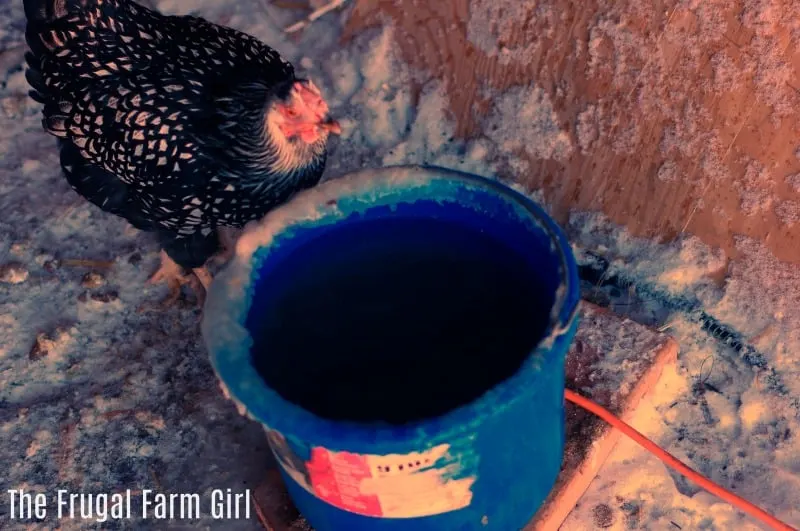
SALTWATER BOTTLE TO KEEP WATER FROM FREEZING
I saw this idea floating around on Pinterest. Surprisingly, we found a heated water bucket on the side of the road that still works. Last year, I shoveled a path from the barn down to the bucket, and it worked fine.
This year it’s not happening. Too much snow and wind. So the water bucket is at the edge of the barn- but there is still snow up to it. Unfortunately, some of our chickens refuse to go to it.
We tried an old water bottle filled with half saltwater and half water. We ensured that the lid was tight and that nothing was leaking. An excessive amount of salt can kill chickens.
Then we filled our waterer up, and it worked! Yet for the past week, when the temperatures have been in the negatives, the saltwater wasn’t working.
The water bucket continues to have ice around the rim. It’s just too darn cold. This is a free way to keep your chickens hydrated. Once the temperatures rise again, I will continue using the water bottle method.
Update: I will splurge for the electric waterer if you have it in the budget and your temperature hits below freezing a lot. I finally got one this year.
Our old barn has fallen since we first wrote this post, and we built a brand new barn and put a chicken coop inside. The drafts, oh my, are so much better.
You can also try a heating pad. I read several forums of others trying a reptile heating pad for the chickens, and it worked well. As always, do your research on this before trying.
Like the Zilla Heat Pad, using a heater for chickens is an excellent way to ensure their water stays warm enough for chickens to drink from it all day.
These heat pads are perfect for chickens because they don’t heat up high enough to burn them if they touch them directly. A heating pad for chickens will help them drink lots of water to stay warm.
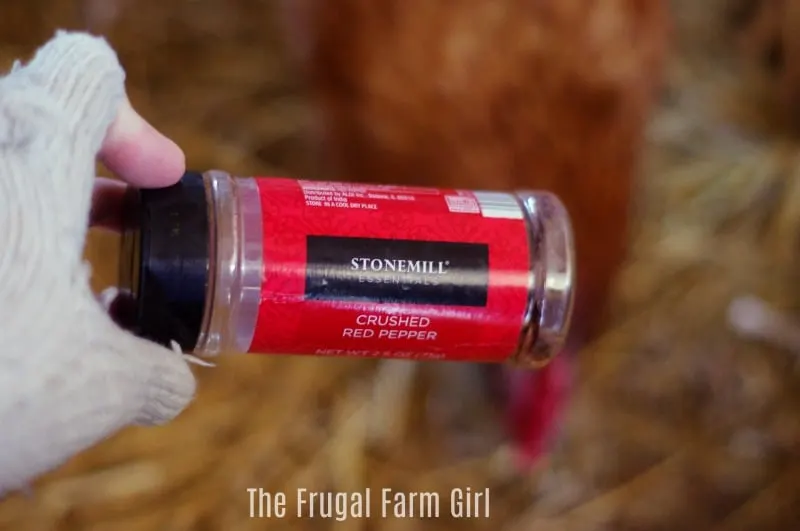
RED PEPPER FLAKES
I have been feeding our chickens Red Pepper flakes I bought from Aldi for under $2! Supposedly this will warm your chickens up. There are a bunch of different spices you can use to create a healthy flock.
I have been doing it the last couple of days, and if anything, it gets them up and moving to increase their blood flow, so it’s a win for me.
Also, there are many articles about cayenne pepper increasing egg production and even saying it thickens the shell of their eggs.
Related:
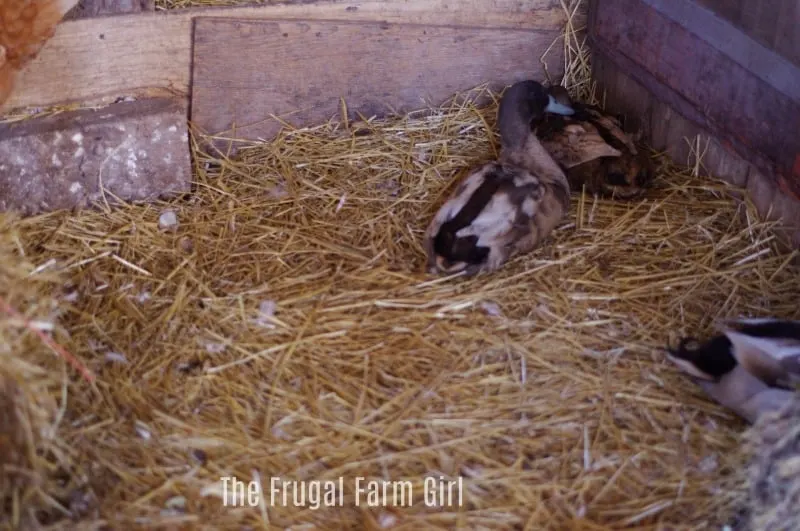
FEEDING EXTRA SCRAPES/TREATS
Our chickens are pasture-raised. They only go in the barn at night. In winter, they have their coop inside the huge old barn. So, for the most part, they hang out in the barn on extreme weather days.
I give them any extra veggie scraps that are not going to our indoor pot-bellied pig. For example, the ends of bread seem to be their favorite. I throw the ends in the toaster, then toss them in a blender and feed to the chickens.
In conclusion, those five tips are the most beneficial. Keep your flock free from drafts, hydrated, and fed should keep them up and alive through the winter months. Always ensure they have a full feeder before they sleep, which keeps them warmer through the night.
We also keep thick layers of straw in the coop and around the barn, where they hang out during the day. Then, we shovel a path from the barn down to the grass when the weather warms up. This gives the chickens a bit of an area to forage.
You can apply these tips to ducks as well. Our ducks share the same coop as our chickens and follow the directions above.
Make use of natural sunlight
Even on colder days, the sun can warm your coop. Place your coop in a spot with plenty of natural sunlight throughout the day to help keep things warm and cozy.
Provide roosting bars
During the cold winter, your chickens will instinctively huddle together for warmth. Providing roosting bars will give them plenty of space to do just that.

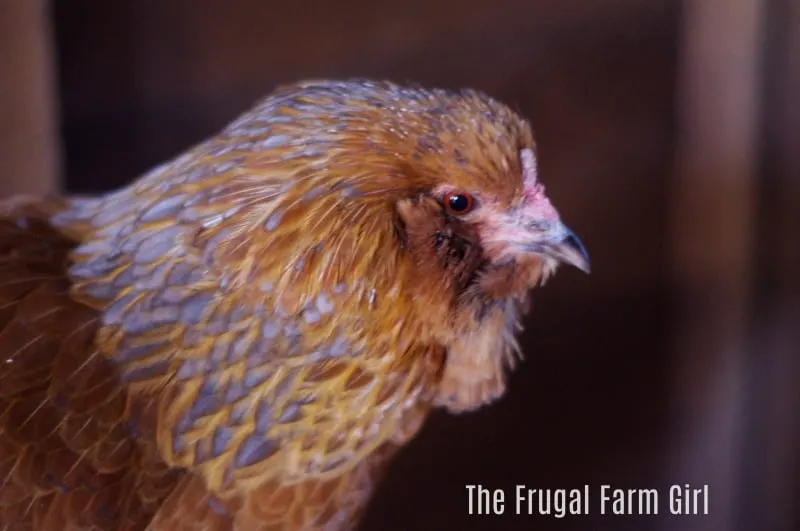
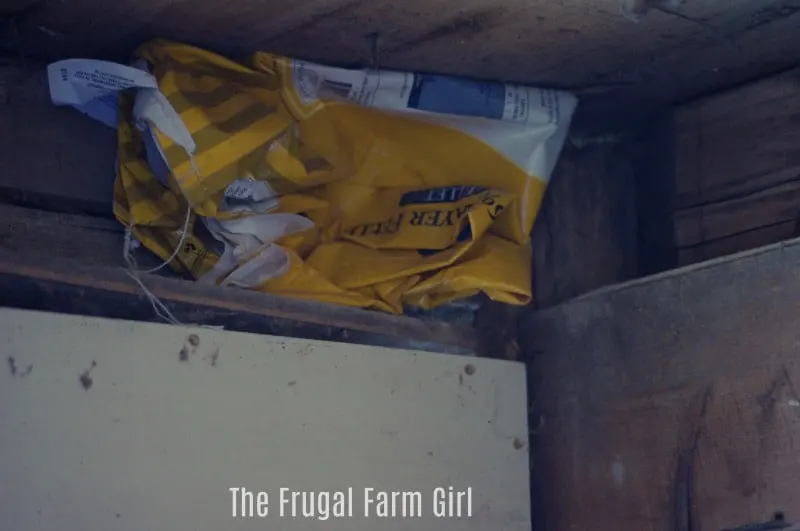
Robleigh
Monday 28th of December 2020
Don't you need to have an area that is partly ventilated for chickens in the coop or is that only in the summer time? We are in Idaho where the winters can be pretty brutal, but I do have ventilation in our coop.
Tasia
Tuesday 29th of December 2020
Yes ventilation is important. In our old barn there was a little too much ventilation! lol it was built in the 1800s. Our new barn is better but there are still so many cracks and holes where air gets through.
Anne Pryce
Wednesday 10th of April 2019
Thankyou for all your ideas we live in Wales and our winters haven't been to bad our hen house is really old used to be pig eggs from the 1930s or before but like you my hubby uses the feed bags to insulate the walls we to use slot of straw and hay never thought of cardboard though and thanks for the red Chile flake idea as well I know we live in different countries but the ideas are mainly the same and it's good to share we've just had some ex battery hens coming out of a shed of about16000 hens to our small henhouse must of been strange but they love being outside and coming in our kitchen and they are so friendly you can't help but love them on and what I wanted to ask was are you mad like me in naming your hens mine have old names like Ethel and Winifred and Aggie and just to say I love following you on Pinterest look forward to more of your ideas and stories.
Tasia
Friday 12th of April 2019
Hi Anne! Thank you so much for sharing a little bit about your family and chickens! We have our favorites named! I love old names. Ours is a little different, Zippy, Minty, Camilia, Noodle, Smokey, and so on and so forth! I am so glad you are following me on Pinterest. We are bringing home more chicks this weekend and I can't wait!
Amber Renee
Thursday 28th of March 2019
I live in Upper Michigan. We've raised chickens for 4 years now and I grew up with them. It gets COLD here. This year we had over a month where the temperature didn't get out of the negatives during the day. The cold doesn't usually last quite that long but, winter lasts six months on average with at least three feet of snow on the ground. The ONLY thing we do to keep the chickens warm is make sure we own cold tolerant chickens. We've never had any frost bite and they go outside all winter long!
Darlene
Saturday 22nd of December 2018
Hello..when I had my chickens...I used flannel- back tablecloths on my walls in chicken coop and sometimes painters plastic...also..old worn out carpet pieces on ground and covered up with lots of hay...
Tasia
Monday 24th of December 2018
Hi Darlene! Thank you for sharing those tips. They are great. I love the flannel table cloth idea!
Naznine Qureashi
Monday 12th of November 2018
i live in New York.....and its gets super cold.i put fresh garlic cloves and a little ACV into the drinking water with a pinch of sea salt. In their food i add Turmeric powder and Cayenne pepper and some Olive or coconut oil. Also give them fruit and vegetables chopped up...from the market ...that have been reduced on sale. Around their run area ...i use the old plastic feed bags...for the wind. Inside the coop...i put a lot of hay.....don't clean their droppings...it actually keeps the coop warm during winter....so i am told.
Tasia
Monday 12th of November 2018
Hello Naznine! Thank you so much for sharing. Yes we don't clean the coop out as often in the winter either. I wouldn't clean it at all during winter if the bottom was dirt but ours is up in the upper part of the barn. I love your tips!